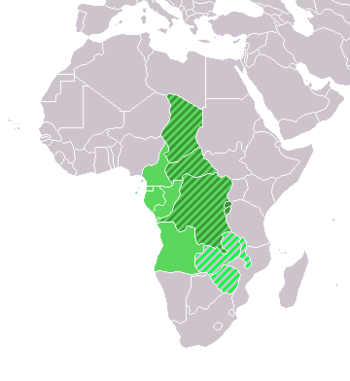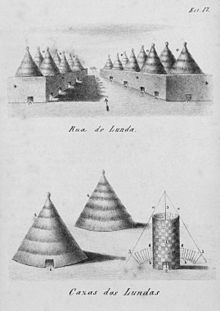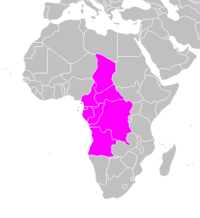- Central Africa
-
Not to be confused with Central African Republic, British Central Africa, or Federation of Rhodesia and Nyasaland.This video over Central Africa and the Middle East was taken by the crew of Expedition 29 on board the International Space Station.

Central Africa is a core region of the African continent which includes Burundi, the Central African Republic, Chad, the Democratic Republic of the Congo, and Rwanda.
Middle Africa (as used by the United Nations when categorising geographic subregions) is an analogous term that includes Angola, Cameroon, the Central African Republic, Chad, the Republic of the Congo, the Democratic Republic of the Congo, Equatorial Guinea, Gabon, and São Tomé and Príncipe.[1] All of the states in the UN subregion of Middle Africa, plus those otherwise commonly reckoned in central Africa (11 states in total), comprise the Economic Community of Central African States (ECCAS).[2]
Contents
Background
The Central African Federation (1953–1963), also called the Federation of Rhodesia and Nyasaland, was made up of what are now the nations of Malawi, Zambia, and Zimbabwe. Similarly, the Anglican Church of the Province of Central Africa covers dioceses in Botswana, Malawi, Zambia and Zimbabwe , while the Church of Central Africa, Presbyterian has synods in Malawi, Zambia and Zimbabwe. These states are now typically regarded as parts of Southern Africa or Eastern Africa.[3]
History
Further information: Early Congolese history and Congo Free StateAround 1000 BCE, Bantu migrants had reached the Great Lakes of East Africa. Halfway through the first millennium BCE, the Bantu had also settled as far south as what is now Angola.
Luba Empire
Main article: Luba EmpireSometime between 1300 to 1400 CE, Kongolo Mwamba (Nkongolo) from the Balopwe clan unified the various Luba peoples, near Lake Kisale. He founded the Kongolo Dynasty, which was later ousted by Kalala Ilunga. Kalala expanded the kingdom west of Lake Kisale. A new centralized political system of spiritual kings (balopwe) with a court council of head governors and sub-heads all the way to village heads. The balopwe was the direct communicator with the ancestral spirits and chosen by them. Conquered states were integrated into the system and represented in the court, with their titles. The authority of the balopwe resided in his spiritual power rather than his military authority. The army was relatively small. The Luba was able to control regional trade and collect tribute for redistribution. Numerous offshoot states were formed with founders claiming descent from the Luba. The Luba political system spread throughout Central Africa, southern Uganda, Rwanda, Burundi, Malawi, Zambia, Zimbabwe, and the western Congo. Two major major empires claiming Luba descent were the Lunda Empire and Maravi Empire. The Bemba people of northern Zambia were descended from Luba migrants who arrived in Zambia during the 17th century.[4][5]
Lunda Empire
Main article: Lunda EmpireFurther information: List of Rulers of the Lunda EmpireIn the 1450s, a Luba from the royal family Ilunga Tshibinda married Lunda queen Rweej and united all Lunda peoples. Their son mulopwe Luseeng expanded the kingdom. His son Naweej expanded the empire further and is known as the first Lunda emperor, with the title mwato yamvo (mwaant yaav , mwant yav), the Lord of Vipers. The Luba political system was retained, and conquered peoples were integrated into the system. The mwato yamvo assigned a cilool or kilolo (royal adviser) and tax collector to each state conquered.[6][7]
Numerous states claimed descent from the Lunda. The Imbangala of inland Angola claimed descent from a founder, Kinguri, brother of Queen Rweej, who could not tolerate the rule of mulopwe Tshibunda. Kinguri became the title of kings of states founded by Queen Rweej's brother. The Luena (Lwena) and Lozi (Luyani) in Zambia also claim descent from Kinguri. During the 17th century, a Lunda chief and warrior called Mwata Kazembe set up an Eastern Lunda kingdom in the valley of the Luapula River. The Lunda's western expansion also saw claims of descent by the Yaka and the Pende. The Lunda linked middle Africa with the western coast trade. The kingdom of Lunda came to an end in the 19th century when it was invaded by the Chokwe, who were armed with guns.[7][8]
Maravi (Malawi)
Further information: List of rulers of MaraviThe Maravi claimed descent from Karonga (kalonga), who took that title as king. The Maravi connected middle Africa to the east coastal trade, with Swahili Kilwa. By the 17th century, the Maravi Empire encompassed all the area between Lake Malawi and the mouth of the Zambezi River. The karonga was Mzura, who did much to extend the empire. Mzura made a pact with the Portuguese to establish a 4,000-man army to attack the Shona in return for aid in defeating his rival Lundi, a chief of the Zimba. In 1623, he turned on the Portuguese and assisted the Shona. In 1640, he welcome back the Portuguese for trade. The Maravi Empire did not long survive the death of Mzura. By the 18th century, it had broken into its previous polities.[9]
Kongo Empire
Further information: List of rulers of KongoBy the 15th century CE, the farming Bakongo people (ba being the plural prefix) were unified as the Kingdom of Kongo under a ruler called the manikongo, residing in the fertile Pool Malebo area on the lower Congo River. The capital was M'banza-Kongo. With superior organization, they were able to conquer their neighbors and extract tribute. They were experts in metalwork, pottery, and weaving raffia cloth. They stimulated interregional trade via a tribute system controlled by the manikongo. Later, maize (corn) and cassava (manioc) would be introduced to the region via trade with the Portuguese at their ports at Luanda and Benguela. The maize and cassava would result in population growth in the region and other parts of Africa, replacing millet as a main staple.
By the 16th century, the manikongo held authority from the Atlantic in the west to the Kwango River in the east. Each territory was assigned a mani-mpembe (provincial governor) by the manikongo. In 1506, Afonso I (1506–1542), a Christian, took over the throne. Slave trading increased with Afonso's wars of conquest. About 1568 to 1569, the Jaga invaded Kongo, laying waste to the kingdom and forcing the manikongo into exile. In 1574, Manikongo Álvaro I was reinstated with the help of Portuguese mercenaries. During the latter part of the 1660s, the Portuguese tried to gain control of Kongo. Manikongo António I (1661–1665), with a Kongolese army of 5,000, was destroyed by an army of Afro-Portuguese at the Battle of Mbwila. The empire dissolved into petty polities, fighting among each other for war captives to sell into slavery.[10][11][12]
Kongo gained captives from the Kingdom of Ndongo in wars of conquest. Ndongo was ruled by the ngola. Ndongo would also engage in slave trading with the Portuguese, with São Tomé being a transit point to Brazil. The kingdom was not as welcoming as Kongo; it viewed the Portuguese with great suspicion and as an enemy. The Portuguese in the latter part of the 16th century tried to gain control of Ndongo but were defeated by the Mbundu. Ndongo experienced depopulation from slave raiding. The leaders established another state at Matamba, affiliated with Queen Nzinga, who put up a strong resistance to the Portuguese until coming to terms with them. The Portuguese settled along the coast as trade dealers, not venturing on conquest of the interior. Slavery wreaked havoc in the interior, with states initiating wars of conquest for captives. The Imbangala formed the slave-raiding state of Kasanje, a major source of slaves during the 17th and 18th centuries.[13][14]
Demographics
Central Africa is a region that is primarily inhabited by Bantu peoples. Bantu languages predominate, with Chadic and Nilo-Saharan languages also spoken in some areas. Christianity, mixed with traditional beliefs in some places, is the predominant religion in Central Africa.
More than 120 million people live in geographic Central Africa.
Countries
Countries in Middle Africa (UN subregion) :
Name Capital Currency Official languages Area (km2) Population  Angola[15]
Angola[15]Luanda Kwanza Portuguese 1,246,700 13,338,541  Cameroon[16]
Cameroon[16]Yaoundé Central African CFA franc French, English 475,442 19,711,291  Central African Republic[17]
Central African Republic[17]Bangui Central African CFA franc Sango, French 622,984 4,950,027  Chad[18]
Chad[18]N'Djamena Central African CFA franc French, Arabic 1,284,000 10,758,945  Democratic Republic of the Congo[19]
Democratic Republic of the Congo[19]Kinshasa Congolese franc French 2,344,858 71,712,867  Republic of the Congo[20]
Republic of the Congo[20]Brazzaville Central African CFA franc French 342,000 4,243,929  Equatorial Guinea[21]
Equatorial Guinea[21]Malabo Central African CFA franc Spanish, French 28,051 668,225  Gabon[22]
Gabon[22]Libreville Central African CFA franc French 267,668 1,576,665  São Tomé and Príncipe[23]
São Tomé and Príncipe[23]São Tomé São Tomé and Príncipe Dobra Portuguese 964 179,506 See also
Wikimedia Commons has media related to: - British Central Africa Protectorate (1891–1907, now Malawi)
- French Equatorial Africa
- West Africa
- East Africa
- North Africa
- Southern Africa
- Subsaharan Africa
- History of Central Africa
References
- ^ "World Macro Regions and Components". United Nations. 2000. http://www.un.org/depts/dhl/maplib/worldregions.htm. Retrieved 2007-12-16.
- ^ "Economic Community of Central African States". Africa-Union.org. 2007. http://www.africa-union.org/root/au/recs/eccas.htm. Retrieved 2007-12-16.
- ^ "The Central African Federation". Encyclopedia Britannica. 2007. http://www.britannica.com/eb/article-43831/Southern-Africa. Retrieved 2007-12-16.
- ^ Shillington (2005), p. 138, 139.
- ^ Davidson (1991), p. 159, 160.
- ^ Shillington (2005), p. 141.
- ^ a b Davidson (1991), p. 161.
- ^ Shillington (2005), p. 139, 141.
- ^ Davidson (1991), pp. 164–165.
- ^ Collins and Burns (2007), pp. 185–188
- ^ Shillington (2005), p. 196–198
- ^ Davidson (1991), pp. 156–157
- ^ Shillington (2005), p. 198, 199.
- ^ Davidson (1991), p. 158.
- ^ "The World Fact book: Angola". CIA Directorate of Intelligence. 2008-05-15. https://www.cia.gov/library/publications/the-world-factbook/geos/ao.html. Retrieved 2008-06-12.
- ^ "The World Factbook: Cameroon". CIA Directorate of Intelligence. 2008-05-15. https://www.cia.gov/library/publications/the-world-factbook/geos/cm.html. Retrieved 2008-06-12.
- ^ "The World Factbook: Central African Republic". CIA Directorate of Intelligence. 2008-05-15. https://www.cia.gov/library/publications/the-world-factbook/geos/ct.html. Retrieved 2008-06-12.
- ^ "The World Factbook: Chad". CIA Directorate of Intelligence. 2008-05-15. https://www.cia.gov/library/publications/the-world-factbook/geos/cd.html. Retrieved 2008-06-12.
- ^ "The World Factbook: Congo, Democratic Republic of the". CIA Directorate of Intelligence. 2008-05-15. https://www.cia.gov/library/publications/the-world-factbook/geos/cg.html. Retrieved 2008-06-12.
- ^ "The World Factbook: Congo, Republic of the". CIA Directorate of Intelligence. 2008-05-15. https://www.cia.gov/library/publications/the-world-factbook/geos/cf.html. Retrieved 2008-06-12.
- ^ "The World Factbook: Equatorial Guinea". CIA Directorate of Intelligence. 2008-05-15. https://www.cia.gov/library/publications/the-world-factbook/geos/ek.html. Retrieved 2008-06-12.
- ^ "The World Factbook: Gabon". CIA Directorate of Intelligence. 2008-05-15. https://www.cia.gov/library/publications/the-world-factbook/geos/gb.html. Retrieved 2008-06-12.
- ^ "The World Factbook: Sao Tome and Principe". CIA Directorate of Intelligence. 2008-05-15. https://www.cia.gov/library/publications/the-world-factbook/geos/tp.html. Retrieved 2008-06-12.
Regions of the world 
Africa Northern · Sub-Saharan (Central · Southern · Western · Eastern) 
Oceania Australasia (Australia) · Melanesia · Micronesia · Polynesia 
America North (Northern • Middle • Central • Caribbean) · South (Southern • Northern • Western) · Anglo · Latin 
Polar Arctic · Antarctic 
Asia Central · Eastern (Northeastern) · Northern · Southeastern · Southern (Indian subcontinent) · Western (Middle East) 
Oceans World · Arctic · Atlantic · Indian · Pacific · Southern 
Europe Central · Eastern · Northern · Southeastern · Southern · Western 
Seas List of seas Related Continents of the world · List of seas · Physical Earth External links
- Travel agency in Central Africa
- Africa Interactive Map from the United States Army Africa
- African Pygmies The first inhabitants of Central Africa
Categories:
Wikimedia Foundation. 2010.







